This article is part of my ongoing “Indie Fighting Game Thursday” review/retrospective series, now on supercombo.gg! This week we talk about Fight’N’Jokes, a 2D MS-DOS fighting game that was recently re-released for modern consoles and will have rollback netcode implemented soon!
It started on the bird app (again)
Social media might be the bane of my existence, but sometimes they are instrumental in finding precious nuggets of information. This is, again, one of those times. A single, seemingly random tweet about a fighting game I didn’t know of sent me again down a deep rabbit hole.
'italian msdos cartoon fighting game getting rereleased on xbox one with plans of adding rollback', I must admit, was not on my fighting game bingo card for 2021
— Melly Fiore 🏳️⚧️ – free 🇵🇸 (@MelvanaChainsII) December 14, 2021
“Italian MS-DOS cartoon fighting game re-released with planned rollback”.
There is a lot to unpack in this short sentence. First, because I haven’t lived the MS-DOS era myself, since I was born at its sunset — My first operating system was Windows 98. Secondly, because we are talking rollback, and, specifically, retrofitting rollback netcode into a 25 years old game. Third, because I’m Italian, like the developers.
The Italian video game development scene is not often represented in the modern fighting game era. True, there are some interesting side scrolling beat’em ups like Gekido Advance: Kintaro’s Revenge and its Switch re-release, by Naps Team; there’s the colorful, crazy button smasher Fly, Punch, Boom! by Jollypunch Games; if we go back to the Amiga period, we have hidden gems like Fightin’ Spirit by Dynamic Style (here a source in Italian) and Shadow Fighter, again by Naps Team; technically, we could also talk about D███t███rg█, but I have already dedicated a whole article to that game and I think it’s more than enough.
That said, bar some small exceptions in the indie area, it’s a bit unusual to learn of new Italian-made fighting games in 2021. This is why I grew interested in Fight’N’Jokes — an Italian fighting game which came out more or less when I was seven years old and was going to be re-released right now.
Curious about the whole ordeal, I decided to reach out for the main programmer, Antonio Lattanzio, asking if he was available to answer some of my questions about his game. To my delight, he agreed to be interviewed… so the ball was now in my court. Since I don’t own an XBox, I at least wanted to try out the original game. I am no journalist, but I have something that resembles a professional ethic: I’m not going to ask questions and write an article on a game I have not played.
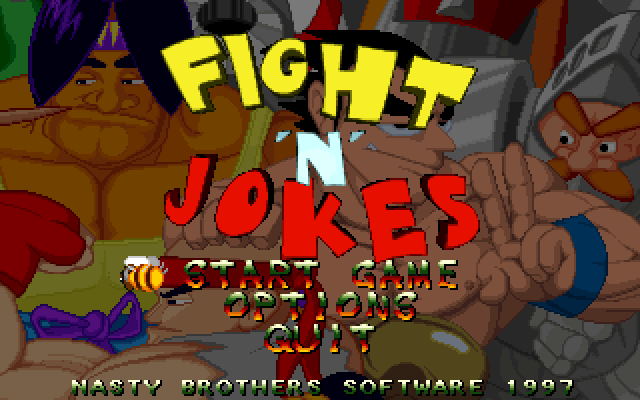
[MS-DOS version] The title screen of Fight’N’Jokes, directly from 1997
Bridging the gap
Of course, I immediately did what any sane man would have done: I went to Discord, delved into the usual The Community Lab server, and asked for clues there. The Community Lab is a bit like Mos Eisley’s Cantina, with more gaming and less light-saber-arm-cutting: You can easily find someone with connections to someone who can fetch you information on some older games, even many lost to the sands of time.
Lady luck had been on my side: in a couple hours, I got my hands on the original MS-DOS version of Fight’N’Jokes and, thanks to Rockforge, EpsilonEagle and GriffyBones, even on a full, 18 pages long, .RTF file containing move lists, strategic tips and tier lists for every character in the game. With my newfound knowledge, it was time to prepare myself for the re-release, by sinking my teeth in the original MS-DOS version of the game!
Fight and Jokes
The original MS-DOS Fight’N’Jokes is a two-buttons 2D fighting game, with wildly animated pixel art sprites. The game sports 14 different characters, many of which are designed around a joke. Miopinja, for example, is a ninja with giant glasses that can become invisible, while Lampaddin is a sunglasses-wearing genie bringing his own lamp with him.
Even if there are only two buttons, the characters have access to several command normals (performed by pressing a direction, including diagonals, plus one of the buttons) and special moves. Specials are performed with traditional motion inputs, but there aren’t any charge motions. Some characters have access to air specials too.
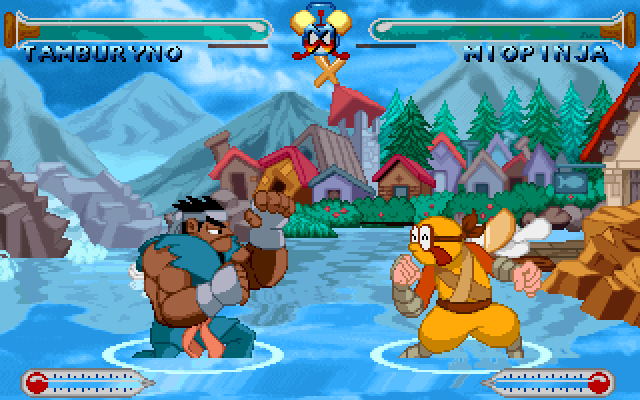
[MS-DOS version] Miopinja’s stage is incredibly well animated. The water movement and splashes are top notch.
There is a super meter, which can be filled by hitting and being hit or charged up by keeping both attack buttons pressed. The meter charges relatively fast. Once it is full, the character will enter a “rage” mode, will start glowing red and will receive a significant damage boost: Hitting with normals or command normals during this “rage” state is one of the fastest ways to end a match.
Each character has also access to a super move, whose input is usually unique per each character and deals respectable damage. Super moves can only be performed during “rage”.
There is also an old-school stun system. Moves performed while in rage have increased stun output too. Prepare to see the opponent (or yourself) stunned more than once in the span of a single round. Rounds can also last pretty long: Blocking is pretty strong and damage outside of “rage” mode is not that high. The best tactic is trying to keep “rage” up as much as possible and use the stellar damage output to finish your opponent before they can do the same.
The original game had some visual quirks: the semi-transparent life bars made it hard to see exactly how much damage was done, and there were some unfinished moves and characters. Nevertheless, it still feels surprisingly responsive and fun to play.
Connecting the dots
Strong of my newfound knowledge about the game, I wrote down the questions for Antonio Lattanzio and sent them to him via Twitter. As we are both Italian, it was a bit curious for me to be able to talk with another fighting game developer in my own native language. Antonio kindly answered all my questions in great detail. In the following, you’ll see what he told me about both the old Fight’N’Jokes and its modern incarnation!
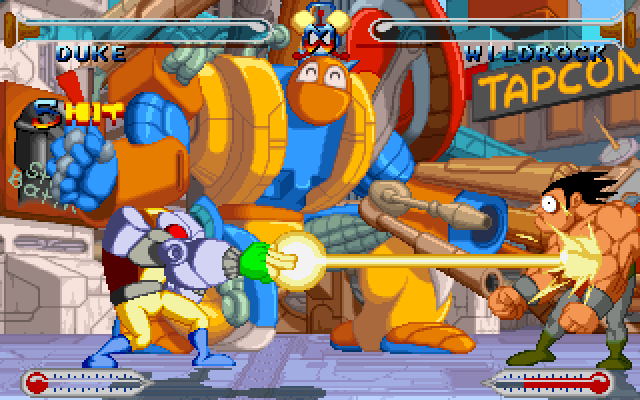
[MS-DOS version] MAKANKOSAPPOOOOOO!
Interview with the developer
Andrea: Hello Antonio! I know it might be strange to start an interview in English, since we are both Italian, but the readers at SuperCombo.gg might not be accustomed to our native language. That said, with I having emigrated to Germany and you to New Zealand, there shouldn’t be any problems, I suppose! First of all, thanks again for accepting to answer my questions about Fight’N’Jokes! When I heard that a seemingly lost Italian MS-DOS fighting game from 1997 was making a comeback almost 25 years later, I couldn’t honestly believe it. Now, for the questions…
Q: Can you tell me what were the origins of the project, how the idea came to be and what were your main sources of inspiration (gameplay-wise)?
Antonio: Back in the 90’s, me and my brothers Cosimo and Raffaele were very passionate about games. We started to build up games years before when we were just kids.
We were lucky as our dad bought us a Commodore 64 in the 80s, which was pretty expensive at that time, and we started to get into the gaming world, and we started to wonder how it was even possible to create a video game.
Then we then discovered “Simon’s Basic” and another software named SEUCK (Shoot’Em Up Construction Kit) which totally changed our vision about game creation, and we started playing with it around, with friends, having so much fun creating stupid games. Good times!
We started to get more confidence that creating a game was maybe possible. Then after a few years the Amiga 500 and Atari 520 ST came out and we discovered other software such as AMOS or STOS where we were able to create some decent games.
But unfortunately it was not enough as those games were not optimized and were running very sluggish on computers of that time, forcing me to focus on optimization techniques and then immediately moving on MS-DOS programming, in Assembly 386 / 486, and Watcom C/C++. That was the time when we came up with the idea of Fight’N’Jokes. It was 1990 and I was 14 years old, when I started coding in C/C++ and ASM. I was collecting all the resources around libraries and ordering books online from US shops. It was very hard to find information! Eventually we built up a demo of a game similar to Mortal Kombat in 1994, together with a parody game prototype which we showed around and was appreciated by a publisher in Italy named Event, which was interested to publish our game on MS-DOS platforms. This happened in 1995, and I remember clearly that me and my brother Cosimo, and Frankino (Francesco Lupo) went to Milan to deal with them. We were so broke that we ended up sleeping on the streets at the train station of Milan! Scary experience but today we still remember it as it sounds very funny!
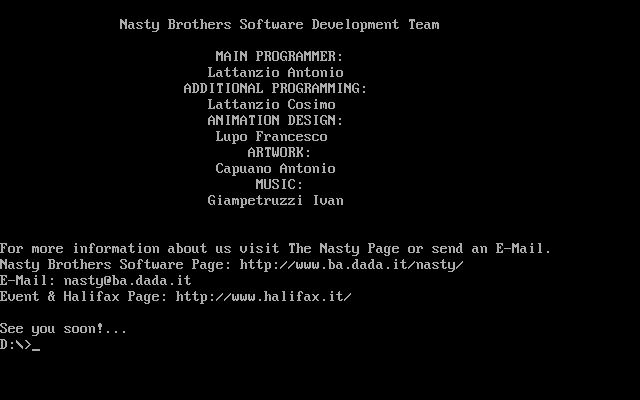
[MS-DOS version] the motley crew who made this game: Nasty Brothers at their best!
The game received amazing reviews from local magazines for that time, even if it was in a primordial state compared to the current version, but unfortunately it was not a great success as the games were not interested anymore to pixelized games, but everything was moving to the 3D market and the spreading of internet started to globalize the information all around the world.
Q: What was the reception, at the time? I was only seven years old, so my memory of those days might be a little bit hazy and I can’t say I was reading many video games magazines when the game came out…
Antonio: The reception was great! As I said earlier, the Internet was not used at all, and even if it came out recently around 97 / 98, people were still skeptical about using it. Also because it was all working with the old Modems Dial Up system, which means that your phone line at home was going to be busy.. and if you were living with your parents it was not going to be fun for them! [laughs]
We received amazing reviews and articles from Zeta (8/10) Kappa (890/1000), PC GameParade, and The Games Machine magazines… which was unbelievable for that time, especially because I was not very happy with the implementation of the game.
However, it was great! And made us believe that we did a great job.
Q: What prompted you to decide to port it to modern consoles and PCs with no less than rollback netcode implemented?
Antonio: In my career I’ve been working for a lot of different companies. In Australia, Sweden, Italy, New Zealand… such as Avalanche Studios, Krome Studios, Gameloft, Milestone. One of my ex-colleagues, Daniel Stephens, one day asked me why I still have Fight’N’Jokes code and I could not port it. At that time I was working on a totally new version of Fight’N’Jokes, so I explained to him that the main reason was that the game was mostly written in Assembly x86 and it was not really portable. After a long discussion, he pointed out to me that it was possible to refactor that code, even if ancient, messy and written by a teenager.. and eventually emulate an old MS-DOS style game even on modern consoles.
Thanks to Dan’s help and immense knowledge the project started and especially because I had the Production Assistance support from the amazing Lena Yaroshenko of Lighstromo.
Realistically speaking, without them, this project wouldn’t exist today, and Fight’N’Jokes was still going to be forgotten and lost into the dark games or vaporware !
The Rollback Netcode became necessary, especially after reviewing the modern games and the community built around it. We already have that part implemented and our team is actually fixing up all the small bugs to ensure that the next update will have a solid online experience, and eventually lead us to work on a sequel!
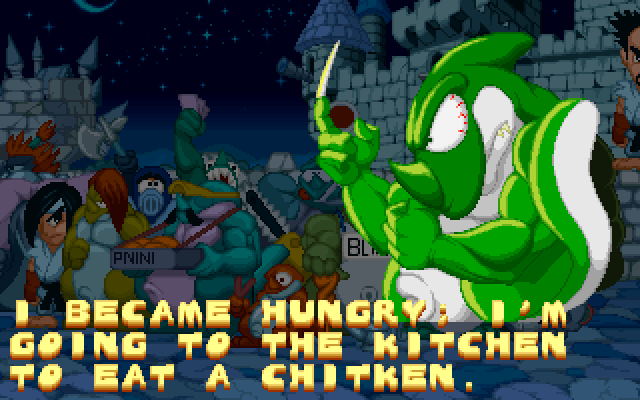
[MS-DOS version] the art-style can be described as a mixture of cartoons and Italian comics, and it feels quite unique even after so many years.
Q: Are/were there many technical challenges in implementing GGPO or a similar rollback library in such an old code base? What language was the game originally written in?
Antonio: The main requirements for implementing the rollback network code are:
- Deterministic gameplay. Each frame must have a constant progression NOT based on time.
- Save and Load of game state. This was quite easy to add as I’ve worked before on a project named the Game Room for Krome Studios / Microsoft where we actually implemented a feature to record the entire gameplay and eventually go backwards while playing.. for instance if you die, you could rollback in a classic arcade game and try again, without restarting the entire game! It is quite cheating but it was one of the requirements for that project, which unexpectedly is the same requirement for the rollback code! So just saving the used values in a memory structure does the trick!
- Game Simulation without rendering. This is pretty much calling the update of the game without drawing anything, since we might need to step forward in the game very quickly because there was a lag.
- And as said before, the original code was written in Assembly 8086 and C/C++ which made it extremely easy adding the Rollback Network logic.
Q: I have had the pleasure of checking out the original Fight’N’Jokes thanks to DOSBox and I must say that it holds up very well to today’s standards. The animations are very fluid and the game feels extremely responsive. Is the game getting any change e.g. balance tweaks, new specials and similar stuff for the updated re-release?
Antonio: We changed a lot of things. The original game had a lot of problems which we could not even figure out at the time, as we had not much time for QA and the game itself was written with a limited knowledge of coding. Some moves were broken or not working at all and we reviewed and fixed all of those! In the meantime we also found some small glitches which will be fixed in the next updates.
Q: I have noticed that one character (Dirty Fat) has only one special move – at least, only one that we could find. Was he somehow unfinished in the original game or was it by design?
Antonio: We have added more moves to Dark Father (not Dirty Fat anymore as we had to change his name to make it not sound inappropriate) We will eventually add another super move on the next update as it needs to be even more evil and hard to beat!
Q: I was intrigued by the super meter/rage mechanic. When the meter is filled, one single counter hit can be lethal, without even needing a super move. It reminded me a bit of Samurai Shodown’s rage. What were the design decisions behind it?
Antonio: We were obsessed by games such as The King Of Fighters, Street Fighter Alpha series and Samurai Shodown at the time the game was developed.
We tried to give the player a valid reason to fill up the meter and make it more interesting to play and eventually give the possibility to an inexperienced player to win a challenge where is obviously losing!
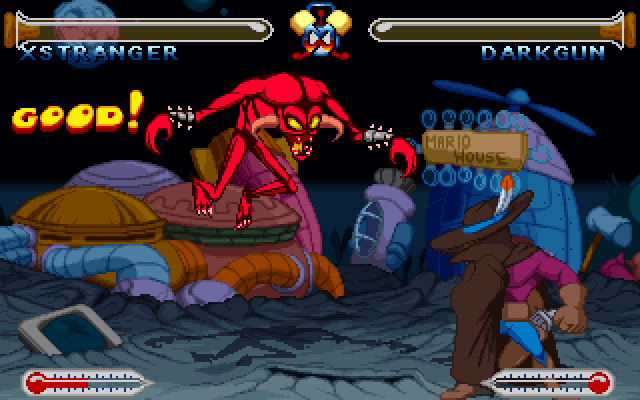
[MS-DOS version] Character sprites and stages are a feast for the eyes.
Q: Three players in The Community Lab Discord server, who acted as consultant for this interview – with usernames Rockforge, EpsilonEagle and GriffyBones – have extensively labbed the original game and written some pages of documentation on it, detailing potential infinite combos, pros/cons of every character, and even tier lists. Were you aware that there were still people checking out the original DOS release in the 2020s?
Antonio: I was not aware of those, and I am amazed to know that there is a community that is into retro games. I would be very happy to review it and take some advice from those super experienced players!
Q: Speaking now of character designs, I might have noticed some Jacovitti and Silver influences in the art style. Was the game’s art style inspired by the Italian comic book school?
Antonio: Our team has always been passionate about Anime, Manga and Comedy comics such as Jacovitti and Silver for sure! Everyday we were creating new characters or coming out with new ideas which were affecting the entire development of the game at that stage, and eventually creating huge issues! But we were too young to care about that, so on a daily basis we were creating new characters.. new moves, new features, and implement them in a few hours!!! We were too excited to stop and we wanted to see our creations alive in the shortest time possible… The original artists of our team were and are still today Francesco Lupo (Frankino) and Antonio Capuano and they worked very hard to make our game look fun! But we also had the huge contribution by my brothers Cosimo and Raffaele together with our crazy Musician and Sound Composer “Ivan Giampetruzzi”.
Q: Also, I must say I had quite some fun with the character names. Lampaddin and Miopinja are puns that work well in our native language! What was the general process in creating a character for the game, name included? What came first, the joke or the design?
Antonio: We were coming up with new jokes everyday. We were finding nicknames for anything possible so it was kind of easy to create some funny names for those characters which eventually became their final names! In the beginning those were temporary names but we liked them so much that we decided to leave them!

When I played Fight’N’Jokes, the first thing that jumped to my mind was the art style of Benito Jacovitti, an Italian comic book artist mostly known for his character Cocco Bill. [Source]
Q: 25 years is a darn long time, I can’t even imagine how it might have been for you to make this trip down memory lane again. Do you want to tell something to the new players who might find Fight’N’Jokes for the first time?
Antonio: I just want to tell everyone that we had a lot of fun creating this game. I really hope that you enjoy it when you play it and that you can see glimpses of the teenage years of a group of irresponsible guys with the dream of creating their own game, where there was no internet, no engines, no way to communicate with the rest of the world.
We tried very hard to take this game up to date, and it will eventually see a sequel at some stage. If you are a developer or not, and you have a dream you should not give up on it cause time runs out and you still can! I learned it the hard way when two of the voice actors of the game passed away tragically too young, too early.
If you like our game, our videos, or ideas… just leaving a like, a comment or an idea would make us very happy because we will know that you liked our work and gives us so much happiness and motivation knowing that some people appreciate what we did 25 years ago.
Thanks again for your time and your availability, I will be sure to check out the updated re-release of the game as soon as it comes out on PC!
Closing thoughts
Thanking once more Antonio for his kindness, I think it’s remarkable how a game that was created so many years ago and is almost as old as me (almost) has still so much to say today. As a small-scale developer myself, I want to double down on his words: If you have an idea, don’t be afraid to try and make it reality. The right moment to start your project was yesterday. The next right moment is today 😉
If you want to try out the re-release of Fight’N’Jokes, you can buy it for Xbox at this link for 19.99USD (regional prices might apply). Nintendo Switch and PC versions are scheduled for the beginning of 2022. The developer also set up a new Discord server for the game, that can be accessed at the following link.
Summary
Name: Fight’N’Jokes
Developer: Nasty Brothers (original MS-DOS version), Mental Drink Ltd (re-release)
Available on: MS-DOS (original), Xbox, soon on PC and Nintendo Switch (re-release)
Price: 19.99€/19.99USD (Xbox DE; XboxUS)
Year of release: 1997 (MS-DOS), 2021/2022 (re-release)
Publisher: Event (MS-DOS), Mental Drink Ltd (re-release)
Netcode: none (original), GGPO rollback netcode (re-release, planned at the moment of writing)
In one sentence: A game from the 90s with accessible gameplay, coming back with a vengeance and a wealth of welcome quality-of-life improvements, who sports a unique cartoon-y style and lots of pop culture references.
Special thanks to The Community Lab server and, especially, to the warring triad, Rockforge, EpsilonEagle and GriffyBones, whose documentation and links helped a lot in writing this article. Special thanks obviously also to Antonio Lattanzio and his development team for accepting to be interviewed and replying to my questions!
This article was dedicated by Antonio to the loving memory of two voice actors who worked with him on the original Fight’N’Jokes:
- Fabio Frezza, who voiced Arturo
- Michele Gissi, who voiced Tamburyno
May your voices and passion still resonate with the people playing this game, as they did when you were among us.

